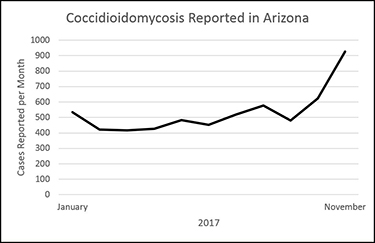Valley fever cases in November saw a 50-percent spike over the previous month, leading experts at the University of Arizona Valley Fever Center for Excellence to predict a significant increase in cases in 2018.
Fortunately, the recent—and timely—approval of a new rapid assay test for Valley fever, developed with assistance from the University of Arizona, should reduce delays in diagnosing the respiratory fungal infections—a frequent problem in treating the disease, which is caused by spores endemic to soils in the U.S. Southwest.
 The number of new Valley fever infections reported to the Arizona Department of Health Services has been relatively stable since 2013, but that may be starting to change, said John Galgiani, MD, director of the UA Valley Fever Center for Excellence and head of the Banner – University Medicine Valley Fever Program. For example, in November, more than 900 cases were reported, a 50-percent increase compared to October and the highest monthly total in the past two years. Although Arizona’s total number of cases for 2017 are only slightly more than in 2016, the accelerating monthly case numbers suggest the state may see a sharp increase in cases next year, he said.
The number of new Valley fever infections reported to the Arizona Department of Health Services has been relatively stable since 2013, but that may be starting to change, said John Galgiani, MD, director of the UA Valley Fever Center for Excellence and head of the Banner – University Medicine Valley Fever Program. For example, in November, more than 900 cases were reported, a 50-percent increase compared to October and the highest monthly total in the past two years. Although Arizona’s total number of cases for 2017 are only slightly more than in 2016, the accelerating monthly case numbers suggest the state may see a sharp increase in cases next year, he said.
“What seems clear is considerably more Valley fever infections are being reported right now,” Dr. Galgiani said. “Arizona clinicians need to be even more alert than usual if their patients develop pneumonia. On average, Valley fever causes one of every three cases of pneumonia in Phoenix, Tucson and surrounding areas. With infections increasing as they are now, pneumonia is even more likely to be due to our local fungal infection.”
 Patients who develop persistent symptoms of pneumonia, such as fever, cough, chest pain, or shortness of breath, especially if associated with unusual skin rashes, joint pain or extreme fatigue, should ask their doctor whether they should be tested for Valley fever.
Patients who develop persistent symptoms of pneumonia, such as fever, cough, chest pain, or shortness of breath, especially if associated with unusual skin rashes, joint pain or extreme fatigue, should ask their doctor whether they should be tested for Valley fever.
In 2011, more than 16,000 Valley fever infections of Arizonan residents were reported—a record for the state. In fall 2010, signs of that increase already were present, Dr. Galgiani said.
“We don’t know if 2018 will be like what we saw in 2011,” he added. “What we are seeing this fall, however, is very similar to how that epidemic [DM1] started seven years ago.”
Earlier this month, the U.S. Food and Drug Administration gave regulatory clearance for a molecular assay test for rapid detection of coccidioidomycosis (Valley fever, or cocci) using DxNA LLC’s GeneSTAT.MDx Coccidioides test and GeneSTAT System. That test (which reduces the time for results from as long as 21 days to the same day and without need for a Biosafety Level 3 lab to do culture testing) was developed using data licensed from the Translational Genomics Research Institute (TGen) and Northern Arizona University. Among sites that assessed the test were Banner Health and Laboratory Sciences at Banner – University Medical Center Phoenix and the UA BIO5 Institute, under Anne Wertheimer, PhD, associate director, Infectious Disease Research Core, and director, Diagnostic Laboratory Sciences, UA Applied Sciences Graduate Interdisciplinary Program.
“My lab in the UA BIO5 Institute was one of the three external validation and reproducibility testing sites and my team collected prospective, as well as a handful of retrospective, specimens,” Dr. Wertheimer said. “The assay was very robust for use by both entry-level as well as highly skilled technicians and eliminates exposure of lab personnel to a highly infectious culture.”
Dr. Galgiani facilitated the collaboration between DxNA and the UA BIO5 Institute and said a possible future improvement for the test is a move from using bronchoscopy specimens to sputa as the test sample. Dr. Wertheimer said her lab would be involved in that validation as well.
Lisa Shubitz, DVM, a research scientist with the UA Valley Fever Center for Excellence and associate professor with the UA School of Animal and Comparative Biomedical Sciences, said data is unavailable for the number of animals affected by Valley fever but dogs seem to be the most impacted.
“Valley fever in dogs is characterized most commonly by coughing, lethargy, lack of appetite, weight loss (often rapid) and fever,” she said. “They may exhibit lameness or back or neck pain without any respiratory signs if the disease goes to the bones, or they might have fever with the bone disease.”
Dr. Shubitz is among several UA researchers working on testing a vaccine for dogs developed at the UA that recently was licensed by Anivive Lifesciences, of Long Beach, Calif., in another project funded by a $4.8 million National Institutes of Health grant.
About the UA Valley Fever Center for Excellence
In 1996, the Arizona Board of Regents established the University of Arizona Valley Fever Center for Excellence to address problems created by the fungus, coccidioides, the cause of Valley fever. Some cases are mild; some so severe that it spreads past the lungs. The disease also affects animals, including pets and livestock. The center works to spread public awareness and education about Valley fever, promote high-quality care for the disease and pursue research to improve treatment therapies and develop a vaccine. To learn more, please visit vfce.arizona.edu
About the Banner – University Medicine Valley Fever Program
The Banner – University Medicine Valley Fever Program is a collaboration between the UA Valley Fever Center for Excellence and Banner Health. The program focuses on reducing delays in accurate diagnosis of patients who develop Valley fever, optimizing their medical care and providing a platform to conduct research and clinical trials to improve understanding of this disease. Studies under way at the center, including one funded by the U.S. Centers for Disease Control and Prevention to evaluate delays in diagnosing the infection, address the value of early antifungal treatment and immunogenetic differences in patients responsible for disease severity.
About the University of Arizona Health Sciences
The University of Arizona Health Sciences is the statewide leader in biomedical research and health professions training. The UA Health Sciences includes the UA Colleges of Medicine (Phoenix and Tucson), Nursing, Pharmacy and the Mel and Enid Zuckerman College of Public Health, with main campus locations in Tucson and the growing Phoenix Biomedical Campus in downtown Phoenix. From these vantage points, the UA Health Sciences reaches across the state of Arizona and the greater Southwest to provide cutting-edge health education, research, patient care and community outreach services. A major economic engine, the UA Health Sciences employs almost 5,000 people, has nearly 1,000 faculty members and garners more than $126 million in research grants and contracts annually. For more information: http://uahs.arizona.edu. Follow us: Facebook | Twitter | YouTube | LinkedIn
[DM1]Definition - a widespread occurrence of an infectious disease in a community at a particular time. Doesn’t have to be person to person…
NOTE TO MEDIA: For educational pamphlets, brochures, images and graphics related to Valley fever—as well as contact information for University of Arizona faculty knowledgeable about the illness—visit the following webpage: UA Expertise on Valley Fever (Coccidioidomycosis)

